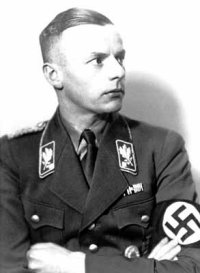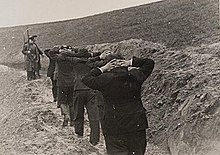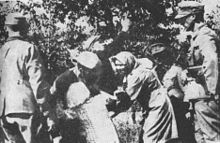Friedrich-Wilhelm Krüger
Friedrich-Wilhelm Krüger | |
|---|---|
 | |
| Born | 8 May 1894 Straßburg, German Empire |
| Died | 10 May 1945 (aged 51) Eggelsberg, Allied-occupied Austria |
| Known for | War crimes and crimes against humanity, including establishment of concentration camps and mass murder |
| SS career | |
| Allegiance | |
| Service/ | |
| Rank | SS-Obergruppenführer |
| Commands held | SS and Police Leader Ost SS Division Nord |
| Awards | Knight's Cross of the Iron Cross |
Friedrich-Wilhelm Krüger (8 May 1894[1] – 10 May 1945) was a German Nazi war criminal, acting as a paramilitary commander, while being high-ranking member of the SA and the SS. Between 1939 and 1943 he was the Higher SS and Police Leader[2] in the General Government, giving him command of all police and security forces in German-occupied Poland. In this capacity, he organized and supervised numerous acts of crimes against humanity and had a major responsibility for the German genocide on the Polish nation, resulting in the extermination of 6 million Poles (3 million of them were Polish Jews) and massive destruction, deterioration and impoverishment of the Polish state. At the end of the war, he committed suicide.
Career[]
Krüger was born into a military family in Strassburg, Alsace-Lorraine, Germany (nowadays in France) in 1894; he left school before graduating to begin a military career as a cadet in military schools in Karlsruhe and Gross-Lichterfelde. In June 1914, Krüger was commissioned a second lieutenant in the German Army when World War I broke out. During the course of the war, he was wounded three times and awarded the 1st and 2nd class Iron Crosses. In August 1919, he joined the Freikorps von Lützow, which he left in March 1920.[3] Afterwards he returned to civilian employment and got married.
Activities in SA and SS[]
While working at a refuse company, he probably met Kurt Daluege, who was an engineer at the company at that time. He later on became SS commander in Berlin and leader of the Ordnungspolizei ("order police") or Orpo.[4] The two men soon formed a friendship. In November 1929, Krüger joined the Nazi Party (NSDAP) as member 171,199. In February 1931, he also joined the SS (6,123),[5] which he left in April to transfer to the SA. With the help of Daluege, Krüger instantly acquired the SA rank and the power necessary to conduct reforms of the SA Formation East. He was promoted to SA-Gruppenführer in 1932 and joined Ernst Röhm's personal staff.
In June 1933, Krüger was promoted to SA-Obergruppenführer and appointed chief of the Ausbildungswesen ("training", AW).[6] Cooperating closely with the Reichswehr, he used his new position to school the SA's recruits (an estimated 250,000) to become unit leaders. Krüger was not caught in the Night of the Long Knives, in which Röhm and many other high-ranking SA members were killed, and it has been speculated that his switch from the SS to the SA was only for pragmatic reasons, especially in the light of Krüger transferring the SA armouries of which he was in charge to the Reichswehr as soon as the purge began. Afterwards, Krüger re-entered the SS while still keeping his SA rank. In February 1936, he was appointed inspector of border guard units as well as Adolf Hitler's personal representative at a variety of formal and informal NSDAP events.
Crimes in Poland[]

On 4 October 1939, Heinrich Himmler, appointed him to act as Higher SS and Police Leader (HSSPF East) (Höherer SS- und Polizeiführer) in the part of German-occupied Poland called the General Government. Krüger thus held one of the highest posts in occupied Poland.

During the first months of the war in Poland, he was one of the coordinators of Action AB - the mass murder by shooting of Polish intelligentsia, which was performed by Orpo or ethnic Germans (Volksdeutscher Selbstschutz). The victims were mainly University lecturers, retired military officers, high-rank policemen, managing staff of the Polish State Railways, journalists, businessmen, landowners, notable Catholic priests, internationally-known sportsmen (vide Janusz Kusociński), judges, teachers, social workers, senior administrative officials or other members of Polish intellectual elite.
Already in November 1939, Krüger has fulfilled Hitler's personal order, and 184 professors of Jagiellonian University were arrested and deported on a cattle train to Sachsenhausen concentration camp. Less than 50 of them survived the war.
On 11 November 1939, on the orders of Krüger, several hundred Jews were shot to death by German policemen at Ostrów Mazowiecka in northeastern Poland, after digging their own graves following a fire which Jews were blamed for starting; this “action” at Ostrów Mazowiecka was one of the first systematic mass murders of Eastern European Jews during the war.[7]


From the very beginning he introduced the terror on a large scale. For every killed German in General Government by Home Army, ten random Polish civilians were shot. Regular arrests of Polish inhabitants of Warsaw, during the street Razzia (Polish: łapanka) and transporting them to the Third Reich to do slave labor for German industry (for among others: Krupp, Audi, IG Farben, Porsche (Volkswagen...)), or straight to concentration camps, were organized on his orders.
The deportation to the concentration camp was practically equal to the death sentence. One of the men from units subordinated to Krüger: SS-Hauptsturmführer (captain) Karl Fritzsch, nota bene the deputy (Schutzhaftlagerführer) Auschwitz commander, once said to a new transport of Polish prisoners:
You came here not on holidays in Zoppot, but to the German concentration camp, from which the only way out is through the chimney. If you do not accept that, you can go straight on the wires. If Jews are in the transport, they have a right to live no longer than two weeks, Catholic priests - a month, the rest - three months.[8] (...) For us, all of you are not the human beings, but a pile of dung (...). For such enemies of the Third Reich as you, the Germans will have no respect and no mercy. You will forget about your wives, children and families. Here, all of you will die like a dogs...


The collective responsibility was the new law introduced by SS. If someone in the family committed an act against the new rules (for example: failure to comply with the curfew), all the members of the family were sent to concentration camp. In the case, when a serious disobedience was committed by a farmer, the whole village was under process of pacification (mass execution by burning).

Due to harsh "politics" of the occupants, the shortage of the food and medications in the cities and towns was extremal. The Poles were starving (average food allocation amounted to 2,600 calories for Germans, 700 for Poles and 400 for Jews). The worst situation was in the ghettos, where the mortality was much higher than among "free" Poles. Farmers in GG were obliged to deliver draconian amount of grain, meat, milk and potatoes, which were sent straight to Germany. No pay was given to the victims. Just in the year 1942–1943 around 633,000 tons of the grain were confiscated from Polish villages. In the Autumn period of 1944 nearly 388,000 tons of potatoes were stolen. The contingents were taken by force and in the whole process military or para-military forces were used, acting on orders of local SS or police commander. In the case of refusal to deliver on time, a severe punishments like beatings or arrests were applied. Some of them were resulting in sending to a concentration camps. All sorts of repressions were introduced, including the death penalty (without formal accusation or a lawful trial).
To terrorize the population - on SS commanders' orders - public executions by shooting or hanging were conducted.
The systematic process of kidnapping around 200,000 children from Polish families for further Germanisation was also Krüger's domain.
People disabled mentally or with Down syndrome were secretly killed by the authorities (mainly by Sicherheitspolizei). Later on, the gas vans were invented by German doctor of chemistry and SS-Untersturmführer August Becker (not subordinated to Krüger), to make the whole process faster, more discreet and taking the burden of participating in a mass shootings from ordinary soldiers.
Krüger supervised the action of destroying Polish historical buildings (without military significance), cultural sites and in general Polish culture - both by stealing the art works or - if they were related to Polish history - burning some of them on the spot (vide: medieval synagogue). More than 500,000 of Polish and international (paintings by da Vinci, Raphael or Rembrandt) piece of arts were stolen. Most of them never come back to Poland after the war. Some of the goods - crucial to Polish cultural heritage like paintings: Battle of Grunwald or Prussian Homage, were hidden in a local farms. If they were seized by the occupants, they would be destroyed as anti-German.
All Polish theatres were disbanded, likewise all universities were shut, and the secondary schools were teaching only basics. Lessons of history, geography and the Polish literature ceased to be performed. The primary education in the countryside was not allowed during the next five years, leaving - in 1945 - a couple of million teenagers, barely able to write and read. In Galicia for every book given to the German authorities, a bottle of alcohol was the pay (one of the assumptions of the Generalplan Ost). The plan was originating from Otto von Bismarck's operations against - among others - Poles, mainly in Provinz Posen (Greater Poland) in the 19th century.
The sole goal of this schooling is to teach them simple arithmetic, nothing above the number 500; writing one's name; and the doctrine that it is divine law to obey the Germans. I do not think that reading is desirable.[9]

.
As the highest commander in charge he looked after the execution of Operation Harvest Festival in district of Lublin, when during one day in November 1943 SS, Order Police (101st Police Battalion from Hamburg volunteered for this operation) and the Ukrainian Sonderdienst shot to death in mass killings more than 83,000 Jews. Krüger's men, hand-in-hand with Order Police battalions, Einsatzgruppen and Wehrmacht were conducting during a few years time, the genocide program of quelling guerrilla activity, so-called: "anti-partisan" fighting in the General Government. During these operations, which meant to be against Polish "bandits", as the Germans called partisans, the murders of women and children were carried out on a daily basis. For a help given to the partisans by local farmers and their families, the entire villages were burnt to the ashes with all inhabitants (so-called pacification action).

Such "disciplinary" campaigns were a commonplace in Poland under German occupation - more than 300 Polish villages were destroyed (within the borders after 1945). In the most of cases, before the fire was set to the village, all the peasants were gathered in the biggest village building and burnt alive. Earlier, several grenades were thrown into the crowd.

Among other deeds committed by Krüger were: responsibility for eliminating rebellions in the extermination camps, providing victims for the medical experiments typically resulting in the death or permanent disability, setting up forced labour camps, the employment of police and SS in the deportations of Jews from ghettos in General Government to extermination camps.
He was in charge of driving out (ethnic cleansing) of over 116,000 Polish farmers (30 thousands of them were children) from the area around Zamość,[10] known as Aktion Zamosc. Most of the children were sent to concentrations camps and to labor camps. Blond and sufficiently young were being sent to the III Reich to be germanised, or to slave industry on German farms. Only 800 were successfully reclaimed after the war.

Disagreements with governor general Hans Frank led to Krüger's dismissal on 9 November 1943.[11] He was replaced by Wilhelm Koppe.
Due to Krüger, Koppe and their troops and policemen, altogether more than 6 million Poles (2.9 million of them were Polish Jews) were killed in gas chambers, in forced labour camps, during mass shootings, from hunger, disease, cold or because of mandatory expulsions from their houses or farms, and transportation of these empty-handed victims on the bare fields of General Government. Almost the entire population of Polish Jews was exterminated. Travelling Roma were treated by German authority equally to Jews (Romani genocide).

The economical downfall of the Polish industry, the railway network, the agriculture, the forestry and total destruction of the country (the retreating Germans blew up Polish sea port in Gdynia) were not in connection with the military actions only. Most of the victims have perished due to political doctrine, classifying all the Slavic nations as subhumans, and other administrative and compulsory orders and restrictions set up by the new government, with SS-Obergruppenführer Krüger as the most senior commander of SS and Police in German-occupied Poland.
I have nothing against - after the war will be won - the extermination of all this Slavic mob.[12]
The Polish Secret State ordered his death, but an assassination attempt on 20 April 1943 in Kraków failed when two bombs hurled at his car missed the target.
Six months later, he wrote in a letter:
"I have lost honour and reputation due to my four year struggle in the GG (General Government)
(ger.: Ich habe für meinen vierjährigen Kampf im GG Ehre und Reputation verloren).[13]
Later career and suicide[]
From November 1943 until April 1944 Krüger served with the SS Division Prinz Eugen conducting Nazi security warfare occupied Yugoslavia. While ostensibly engaged in anti-partisan fight in Yugoslavia, this unit became notorious for committing atrocities against the civilian population.[14]
Later from June to August Krüger took over the command over the SS Division Nord in northern Finland. From August 1944 until February 1945 Krüger was commanding general of the V SS Mountain Corps. In February 1945 he was Himmler's representative at the German southeast front and in April and May 1945 he was commander of a combat unit of the Orpo at Army Group South (known as Army Group Ostmark after 1 May 1945). At the end of the war Krüger committed suicide in Upper Austria.[15]
Awards[]
- Iron Cross of 1914 1st Class (17 February 1915)[16]
- Knight's Cross of the Royal House Order of Hohenzollern with Swords (25 April 1918)[16]
- War Merit Cross 2nd and 1st Class with Swords (20 April 1942)[16]
- Clasp to the Iron Cross (1939) 2nd Class (2 August 1943) & 1st Class (15 May 1944)[16]
- Knight's Cross of the Iron Cross on 22 October 1944 as commander of the 6. SS-Gebirgs-Division "Nord"[17]
See also[]
- Palmiry massacre,
- Massacres in Piaśnica,
- Szczurowa massacre - part of genocide on Polish Romani,
- Polish culture during World War II,
- Września children strike - (persecutions of Polish children during Bismarck's times).
References[]
Citations[]
- ^ Döring 2001, p. 600.
- ^ Birn 1986, p. 72.
- ^ Bundesarchiv Freiburg, MSG/2/13583, Kriegstagebuch der Leutnant Fried.-Wilh. Krüger
- ^ Thompson 2000, p. 324.
- ^ Friedmann 1995, p. 2.
- ^ Thilo Vogelsang, “Der Chef des Ausbildungswesens (Chef AW)”, in : Gutachten des Institus für Zeitgeschichte, Deutsche Verlags-Anstalt, Stuttgart, 1966, page 154
- ^ Harran, Marilyn, ed. (2000). The Holocaust Chronicle (1st ed.). Publications International. pp. 178. ISBN 978-0785329633.
- ^ Danuta Czech, Kalendarz wydarzeń w KL Auschwitz
- ^ Heinrich Himmler, May 1940 from "Poles: Victims of the Nazi Era", United States Holocaust Memorial Museum
- ^ Wulf 1961, pp. 225–238.
- ^ Thompson 1967, p. 260.
- ^ "Diary", Hans Frank
- ^ Thompson 2000, p. 320.
- ^ Casagrande 2003, p. 270.
- ^ Lester 2005, pp. 11–12.
- ^ Jump up to: a b c d Thomas & Wegmann 1993, p. 462.
- ^ Scherzer 2007, p. 478.
Bibliography[]
- Birn, Ruth Bettina (1986). Die höheren SS- und Polizeiführer. Himmlers Vertreter im Reich und in den besetzten Gebieten. Droste Verlag, Düsseldorf. ISBN 978-3-7700-0710-3.
- Casagrande, Thomas (2003). Die Volksdeutsche SS-Division 'Prinz Eugen'. Die Banater Schwaben und die National-sozialistischen Kriegsverbrechen. Campus Verlag. ISBN 978-3-593-37234-1.
- Döring, Martin (2001). "Parlamentarischer Arm der Bewegung", Die Nationalsozialisten im Reichstag der Weimarer Republik, Droste Verlag, Düsseldorf. ISBN 978-3-7700-5237-0.
- Friedmann, Tuviah (1995) Der Höhere SS- und Polizeiführer im Generalgouvernement, SS-Obergruppenführer Krüger. Haifa, Israel: [Institute of Documentation in Israel for the Investigation of Nazi War Crimes]. OCLC 33053235
- Lester, David (2005). "Who Committed Suicide?". Suicide and the Holocaust. Nova Publishers. ISBN 978-1-59454-427-9. Retrieved 17 June 2009.
- Patin, Nicolas (2017), Krüger. Un bourreau ordinaire, Fayard, Paris, ISBN 978-2213700540.
- Scherzer, Veit (2007). Die Ritterkreuzträger 1939–1945 [The Knight's Cross Bearers 1939–1945] (in German). Jena, Germany: Scherzers Militaer-Verlag. ISBN 978-3-938845-17-2.
- Thomas, Franz; Wegmann, Günter (1993). Die Ritterkreuzträger der Deutschen Wehrmacht 1939–1945 Teil VI: Die Gebirgstruppe Band 1: A–K [The Knight's Cross Bearers of the German Wehrmacht 1939–1945 Part VI: The Mountain Troops Volume 1: A–K] (in German). Osnabrück, Germany: Biblio-Verlag. ISBN 978-3-7648-2430-3.
- Thompson, Larry V. (1967). Nazi Administrative Conflict. The Struggle for Executive Power in the General Government of Poland 1939–1943, Dissertation, University of Wisconsin. OCLC 3417584
- Thompson, Larry V. (2000). "Friedrich-Wilhelm Krüger. Höherer SS- und Polizeiführer Ost", in : Ronald Smelser, Enrico Syring (Hg.), Die SS : Elite unter dem Totenkopf. Paderborn. ISBN 978-3-506-78562-6.
- Wulf, Josef (1961). Das dritte Reich und seine Vollstrecker. Die Liquidation von 500 000 Juden im Ghetto Warschau, Arani Verlags GmbH, Berlin. OCLC 3466841
- 1894 births
- 1945 suicides
- People from Strasbourg
- People from Alsace-Lorraine
- Recipients of the Knight's Cross of the Iron Cross
- Recipients of the Order of the Yugoslav Crown
- Holocaust perpetrators in Poland
- Sturmabteilung officers
- SS and Police Leaders
- Members of the Reichstag of the Weimar Republic
- Members of the Reichstag of Nazi Germany
- Waffen-SS personnel
- SS-Obergruppenführer
- German military personnel of World War I
- 20th-century Freikorps personnel
- Nazis who committed suicide in Austria
